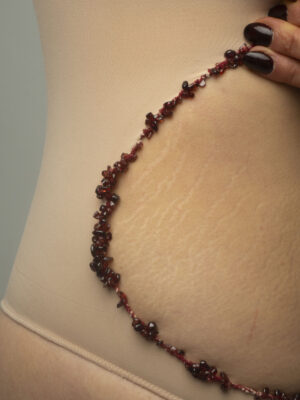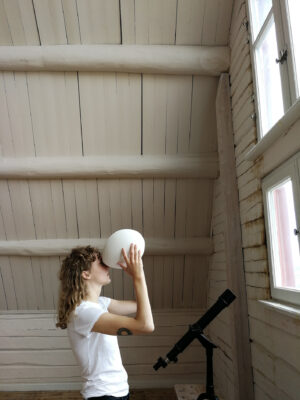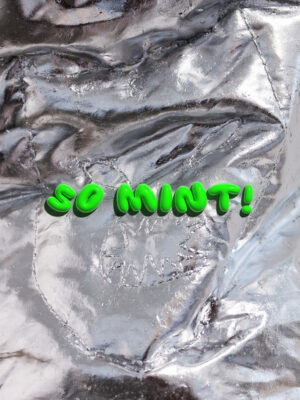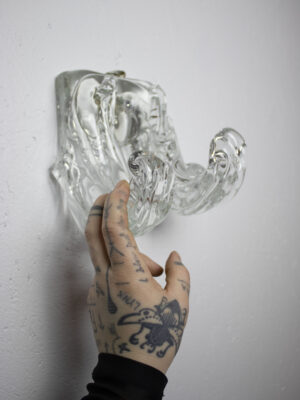When I first encountered her work, it felt like an instant connection—intuitive and deeply personal. After our interview, my admiration only deepened as I uncovered new layers in her art. Now, preparing for her first solo exhibition in Mannheim, Germany, Helena aims to create an immersive experience. I invite you to dive into the interview to learn more about her fascinating practice and to experience her work firsthand at her upcoming solo exhibition.
___STEADY_PAYWALL___
Vica Gábor: On your website, you write that your work initiates a dialogue about the tension between ideal physical appearance, reality, individual desires, and societal norms. What personal experience or observation led you to explore these themes in your art?
Helena Renner: I’ve never had the kind of body that matched those of my peers or the images I saw in magazines and advertisements. From a young age, I became aware of this difference—partly through internal comparisons, but also through external experiences like bullying and negative comments. I realised that I was treated differently by teachers, classmates and potential romantic interests. Instead of questioning society’s expectations, I internalised the message that something was wrong with me. So, body image has been on my mind for as long as I can remember.
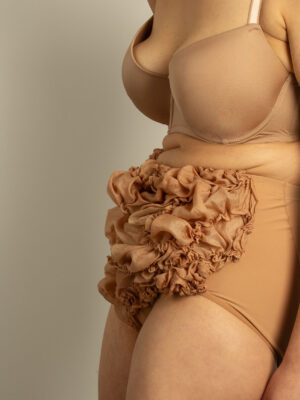
After years of fluctuating between weight gain and attempted weight loss, I decided to make a lasting change during the pandemic in 2020. I began counting calories, exercising regularly, and eventually lost 25 kilograms over nine months, about 40 kilograms from my highest weight. My hope was that once I reached this goal, I could finally stop obsessing over my weight and simply live, thin and happy.
But that didn’t happen. Instead, I became hyper-focused on my appearance, constantly finding new flaws. Although others saw my transformation as a success and showered me with praise and newfound attention, I felt disconnected. I was still the same person inside, carrying the same memories and insecurities, only in a different body. The dissonance between how I felt and how others now perceived me was deeply unsettling. That experience made me want to explore and understand what was really happening, both within myself and in the world around me. This exploration became a driving force in my artistic work.
VG: Your work encourages the viewer to question our perceptions of the constantly changing beauty ideal. What kind of reactions do you expect and what feedback do you usually receive from the audience and other professionals during exhibitions?
HR: Many people who encounter my work for the first time, especially those unfamiliar with me or my artistic approach, are initially surprised or even slightly unsettled. They often don’t understand what they’re looking at or why I’ve chosen to portray the body in this way. But once I explain the personal background behind the work and share my relationship with my own body, something shifts. People begin to open up and often respond by sharing their own experiences. One comment I’ve heard several times is, ‘Oh, the skin on my belly looks just like that after having children!’ While I haven’t experienced childbirth myself and it’s not part of my own bodily history, I’m genuinely glad when others can relate to the work in their own way.
There are also viewers, often women around my age, who immediately connect with the themes. It’s usually clear from our conversations that they’ve faced similar struggles growing up. Negative feedback is rare, but when it does happen, I often sense that it comes from people who are dealing with their own body image issues. For some, it’s difficult to understand why someone would choose to be so vulnerable and openly display what is typically considered an ‘imperfect’ body.
The only kind of reaction I really struggle with is when people, usually men, sexualise my work. Some assume that nudity automatically implies sexual intent. On Instagram, for example, certain images have been taken down because the platform’s algorithm flagged them as ‘sexual content.’ But the presence of naked skin does not mean I’m trying to be provocative or seductive. While I might explore sexuality in future projects, this particular body of work is about acceptance, self-reflection and compassion towards ourselves and the bodies we inhabit and encounter.
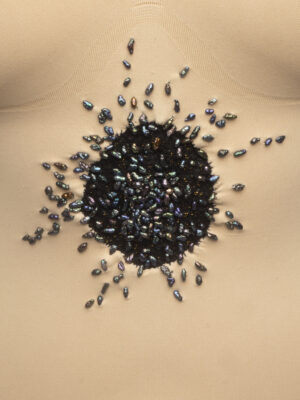
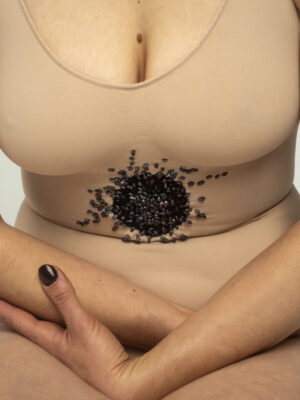
VG: In 2022, you collaborated with Miriam Straké to create the performance titled Encounter. Could you tell us more about this collaboration? How did the idea come about, what was its goal and what did this creative process mean to you?
HR: The performance took place in a public space in Trier, where we were given the opportunity to transform a small kiosk over the course of four days. Our concept centred around reusing everyday household and construction materials, typically found inside buildings, and applying them to the kiosk’s exterior. The goal was to spark a dialogue about sustainability and the role of art in public spaces. Importantly, the act of adding materials during the first half of the performance was just as significant as removing them in the second half, emphasising the impermanence and cyclical nature of transformation.
What stood out most to me were the spontaneous reactions from passersby. Since the kiosk was in a large, highly frequented public area, we encountered a wide range of people—tourists, locals and salespeople—who engaged with the work and often struck up conversations. These exchanges touched on everything from art and sustainability to everyday life. Even though the materials and theme weren’t directly connected to the core subjects of my own art practice, it was my first time creating art in public and explaining my work to complete strangers. That experience really pushed me outside of my comfort zone and gave me a taste of how public engagement can shape an artwork.
We began with a loose concept of how we wanted to transform the kiosk, but without a fixed outcome. This required us to trust our instincts, something that challenged me, since I’m usually very clear about the final result I’m aiming for. Later on, we documented the process through transforming photographs and video stills, which we took during the performance and compiled them into an artist book. This part of the project deepened my understanding of design tools like Photoshop and InDesign, which have since become valuable skills in my practice. All in all, it was an incredibly rich learning experience on many levels.
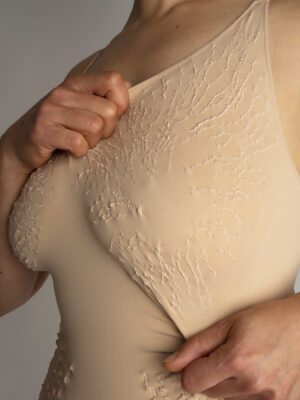
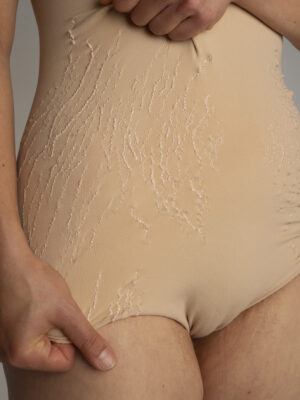
‘I even began seriously considering plastic surgery to remove the loose skin and ‘imperfections’ I still saw. But then I realised, even if I changed my appearance, I would still carry scars as reminders of my body’s past. There’s simply no way to erase every trace of what your body has been through.’
VG: In the text related to your work, Worth it? you write that your artistic practice emphasises the importance of self-acceptance and encourages us to be kinder to our bodies. In what way does your work influence your own acceptance of your body? How do you interpret the process of self-acceptance and how does your creative process connect to your own journey of self-acceptance?
HR: Losing weight and moving closer to society’s beauty standards brought me more positive feedback from those around me. While this validation felt good on the surface, it also made me more critical of myself. I became afraid of gaining the weight back and losing what I had ‘achieved.’ In some ways, this fear felt just as heavy as the experience of living in a larger body. I even began seriously considering plastic surgery to remove the loose skin and ‘imperfections’ I still saw. But then I realised, even if I changed my appearance, I would still carry scars as reminders of my body’s past. There’s simply no way to erase every trace of what your body has been through. So instead of resenting those marks, I started to wonder: what if I could learn to accept my body as it is? To treat it with more care and kindness? After all, it’s the only one I have and it evolves along with everything I experience in life. There are more important things than appearances.
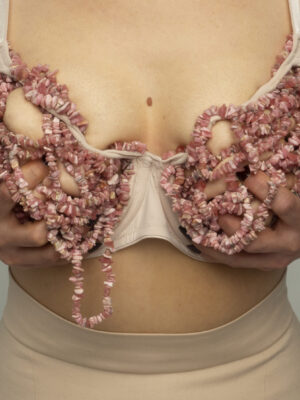
Most of my pieces begin with a specific physical feature I’ve struggled with or an emotional response to how I see myself. I then think about how to build the piece: what kind of clothing or form might relate to the theme, or whether I want to use readymades or create something completely new. After that, I choose materials like fabrics, beads and stones that help express my thoughts and feelings.
Since the body plays such a central role in my work, the process often includes trying the piece on myself while I make it. What looks one way on the table often changes dramatically when worn. That’s why I place so much value not just on the finished object, but also on photographing it on the body. Seeing my pieces worn, especially on ‘imperfect’ bodies like my own, gives them their full meaning.
And in these photos, I see my body differently. I begin to accept my stretch marks, my belly fat, my scars, both internal and external. I’m learning that even the parts of me I find hard to love deserve to be adorned, not hidden. This realisation has been incredibly empowering.
VG: Do you feel that your art resonates with women across all age groups, or does it primarily address the body image struggles of a particular generation?
HR: At a recent event mostly attended by older women, many shared with me that they’ve faced similar struggles with body image throughout their lives. But unlike younger generations, they were never given the space or permission to speak about it openly. Shame was something they learnt to carry silently. Some of them told me they’ve grown more accepting of their bodies with age, while others said the pressure has only increased. I’ve come to realise that this contrast shows just how deeply beauty standards are internalised and how differently they affect women depending on their age, experiences and environment.

What we’re also talking about here is ageism, another layer of oppression within the system of beauty standards, which disproportionately targets women. We’re expected not just to be thin, but also wrinkle-free, firm and youthful at all times. Signs of life like stretch marks, scars, grey hair and loose skin are treated as flaws to be corrected, rather than as evidence of lived experience. This expectation to erase ourselves as we age is profoundly dehumanising. It reduces us to objects meant to please, not to live fully and visibly.
My current work is rooted in my own personal experience, so naturally it reflects the perspective of someone in her thirties. I think this is why, as I mentioned earlier, many women in my age group seem to instantly understand my point and my perspective. Most of us, as we grow up, learn that we should look a certain way and we’re chasing these ideals throughout our lives. But ageing is inevitable, and I can imagine that the way our bodies evolve over time is going to play a role in my work going forward. I don’t want to just passively observe this shift, I want to challenge the narratives that tell us that we lose value as we age. There’s a radical power in making this visible through art, and I see it as part of a broader feminist practice: reclaiming our bodies, our stories, and our right to take up space at every age.
For more information about Helena Renner’s work and her upcoming solo exhibition in Mannheim, Germany, please visit Helena Renner’s website.
Cover image: Wounded • Ready-made bodysuit, garnets, thread • Photo by Marlene Tullius
This year’s theme for our digital publishing is Language. Through a selection of articles we dive into visual languages, the communication of objects, iconography and symbolism. Focusing on story-telling through a lens of aesthetics, we are eager to bring assorted trains of thought to you by twelve different authors. The articles range from speculative to theoretical, chaste to raunchy, past to future, bringing you a variety of voices and perspectives.
This year’s digital publishing features isabel wang pontoppidan as guest editor. isabel is a Danish-Chinese writer, artistic researcher and jewellery maker based in Amsterdam. Her practice is multi-pronged, combining writing, performance, research and jewellery in a variety of overlapping cross-sections.
